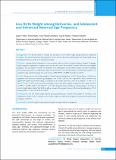Please use this identifier to cite or link to this item:
https://hdl.handle.net/20.500.14356/941| Title: | Low Birth Weight among Deliveries, and Adolescent and Advanced Maternal Age Pregnancy |
| Authors: | Yadav, Gopal Kumar Paudel, Binod Chaudhary, Arjun Prasad Mahato, Gaurav Pyakurel, Prajjwal |
| Citation: | YadavG. K., PaudelB., ChaudharyA. P., MahatoG., & PyakurelP. (2023). Low Birth Weight among Deliveries, and Adolescent and Advanced Maternal Age Pregnancy. Journal of Nepal Health Research Council, 20(3), 653-658. https://doi.org/10.33314/jnhrc.v20i3.3774 |
| Issue Date: | 2022 |
| Publisher: | Nepal Health Research Council |
| Keywords: | Low birth weight Nepal Primary hospital Teenage/adolescent pregnancy |
| Series/Report no.: | July-Sep, 2022;3774 |
| Abstract: | Abstract Background: We did this study to evaluate the prevalence of low birth weight among deliveries, adolescent pregnancy and advanced maternal age pregnancy. We also assessed the factors affecting the low birth weight among institutional deliveries at the level of primary hospital. Methods: A hospital-based retrospective cross-sectional study was done in Grahun Primary Hospital of Syangja, Nepal using data maintained in register book over last five years. We excluded all those deliveries with multiple pregnancy and incomplete records, and included 2473 participants in final analysis using convenient sampling. The relevant information was filled up in Microsoft Excel 2019 v16.0 and descriptive and inferential statistics was calculated using statistical package for social sciences, IBM SPSS® v21 (IBM, Armonk, New York). Results: The prevalence of low birth weight at Grahun Primary Hospital was 11.08%. The prevalence of adolescent pregnancy and advanced maternal age pregnancy was 18.03% and 02.18% respectively. Male newborns had significantly higher mean birth weight as compared to the female newborns (3101.48 ± 506.60 v/s 2967.53 ± 484.97, P-value <0.001). Female newborns had higher odds of low birth weight as compared to those male newborns (11.99% v/s 8.29%, AOR=1.56, 95% CI= 1.17-2.07). Pregnant women with lower gestational age (<37 weeks or preterm) had a higher odds of low birth weight as compared to pregnant women with normal gestational age (37-42 weeks) (AOR = 11.59, 95% CI 8.49-15.83). Conclusions: The low birth weight depends upon gestational age of mother and gender of newborn. Local organizations should work to bring down low birth weight, and adolescent pregnancy and advanced maternal age pregnancy of mother. Keywords: Low birth weight; Nepal; primary hospital; teenage/adolescent pregnancy. |
| Description: | Original Article |
| URI: | http://103.69.126.140:8080/handle/20.500.14356/941 |
| ISSN: | Print ISSN: 1727-5482; Online ISSN: 1999-6217 |
| Appears in Collections: | Vol 20 No 3 Issue 56 july-Sep, 2022 |
Files in This Item:
| File | Description | Size | Format | |
|---|---|---|---|---|
| 3774-Manuscript-30771-1-10-20230314.pdf | Fulltext Article. | 212.76 kB | Adobe PDF |  View/Open |
Items in DSpace are protected by copyright, with all rights reserved, unless otherwise indicated.
